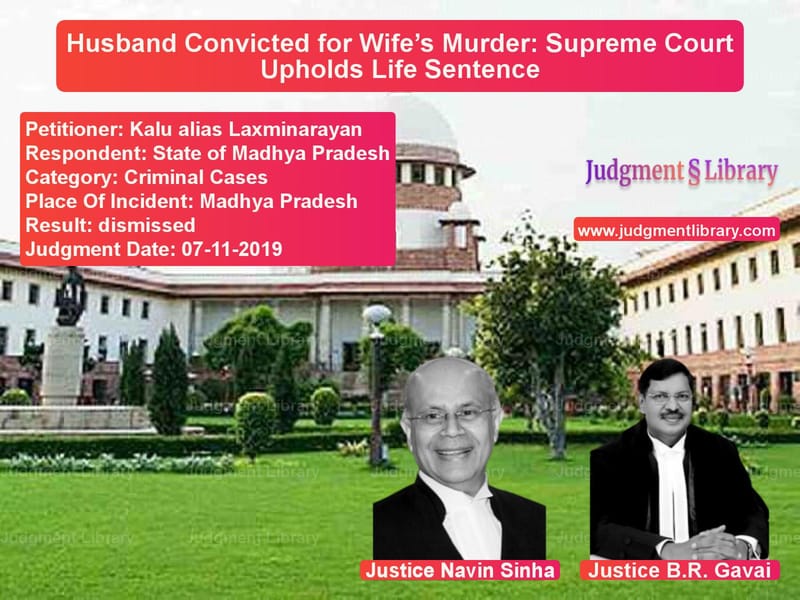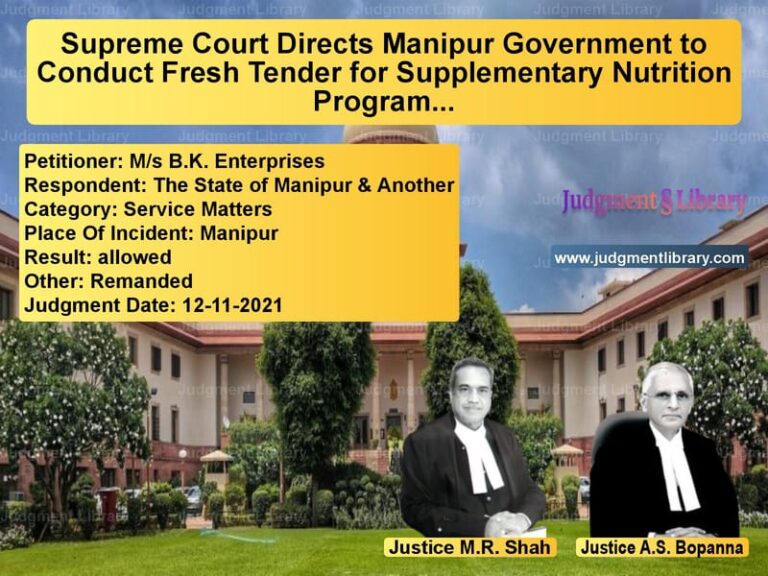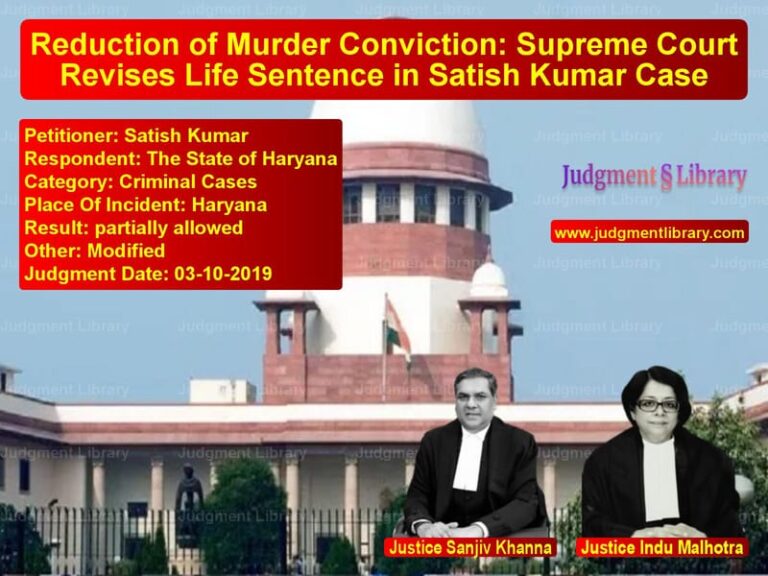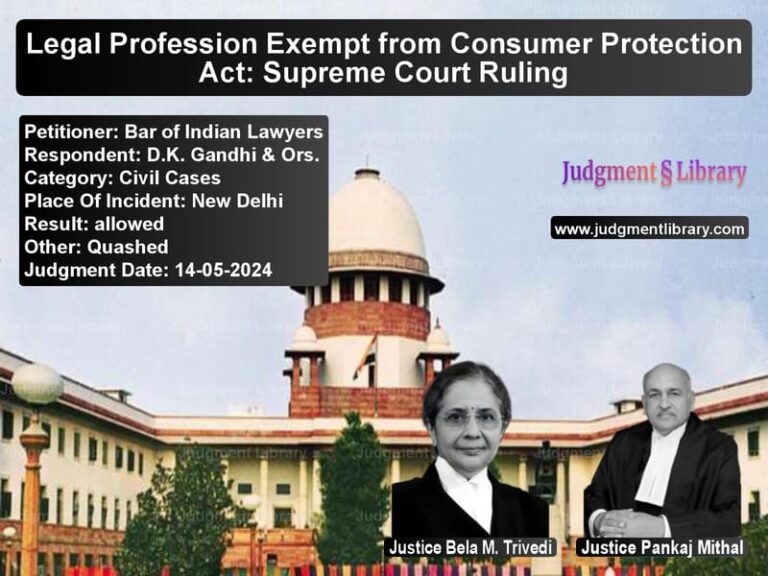Husband Convicted for Wife’s Murder: Supreme Court Upholds Life Sentence
The Supreme Court of India recently upheld the conviction of Kalu alias Laxminarayan under Section 302 of the Indian Penal Code (IPC) for the murder of his wife. The case, which was based entirely on circumstantial evidence, raises critical legal questions about burden of proof, the role of circumstantial evidence in criminal trials, and the duty of an accused to explain an unnatural death occurring within the matrimonial home.
Background of the Case
Kalu alias Laxminarayan was convicted of the murder of his wife, who was found dead under suspicious circumstances at their home. The couple lived alone with their minor child. On October 14, 1994, the family members of the deceased received a phone call informing them of her death. Upon reaching her home the next morning, they found her body lying on the ground in the middle room of the house, covered with a white sheet. The police were informed, and an investigation began.
The police initially filed a chargesheet under Sections 306 (abetment of suicide) and 498A (cruelty to wife) of IPC. However, during the trial, the Sessions Judge added Section 302 (murder) after medical evidence suggested that the deceased had been strangulated to death. The trial court convicted Kalu for murder, and the Madhya Pradesh High Court upheld the conviction. Dissatisfied with the judgment, Kalu appealed to the Supreme Court.
Arguments by the Appellant (Kalu alias Laxminarayan)
The appellant, through his senior counsel, contended that:
- The deceased had committed suicide and was not murdered.
- The conviction under Section 302 IPC was not justified as there was no direct evidence linking him to the crime.
- It was physically impossible for him to have alone hanged the deceased from a height of 11 feet.
- The fact that the body was found on the ground did not rule out suicide, as it was possible that he brought her down from the noose after she had hanged herself.
- If he had strangulated his wife, he could have concealed the dead body or cremated her during the night. His conduct did not indicate guilt.
- The burden of proof lay on the prosecution, and mere presence in the house did not make him guilty.
Arguments by the Respondent (State of Madhya Pradesh)
The prosecution countered the appellant’s claims with the following points:
- The circumstantial evidence clearly pointed to the guilt of the appellant.
- Both the trial court and the High Court had unanimously ruled out suicide.
- The medical evidence suggested that the deceased was strangulated, not hanged.
- The appellant had failed to provide any reasonable explanation for the unnatural death of his wife inside their home.
- His suspicious conduct, including the fact that he was absent when the deceased’s family arrived, indicated his involvement in the crime.
Supreme Court’s Observations
The Supreme Court, after reviewing the evidence and hearing the arguments, made the following crucial observations:
1. Inconsistencies in the Appellant’s Defense
The Court noted that the appellant’s defense was weak and full of inconsistencies. He initially claimed that his wife had committed suicide but failed to explain how she could have hanged herself from a height of 11 feet when she was only 5 feet 4 inches tall. Furthermore, his claim that he had brought her down after she had hanged herself did not align with the medical evidence.
2. Medical and Forensic Evidence
The post-mortem report provided crucial insights:
- There was a ligature mark above the thyroid cartilage, which is more consistent with strangulation than hanging.
- The deceased’s body showed signs of resistance, including abrasions on her fingers and forearm.
- The tongue was inside the mouth, which contradicted typical signs of suicide by hanging.
- Froth and blood were found in the mouth and nostrils, further supporting the theory of strangulation.
3. Section 106 of the Indian Evidence Act
The Court invoked Section 106 of the Indian Evidence Act, which states that when any fact is especially within the knowledge of a person, the burden of proving that fact is upon him. Since the deceased died in her matrimonial home where only the appellant was present, he was duty-bound to provide an explanation for her death. His failure to do so strengthened the prosecution’s case.
4. Behavioral Evidence
The Court found the appellant’s behavior highly suspicious:
- He did not immediately inform the deceased’s family about her death.
- He was absent when her family arrived, raising doubts about his innocence.
- He failed to provide any alibi or alternative explanation under Section 313 of the Code of Criminal Procedure (CrPC).
5. Legal Precedents
The Court relied on multiple legal precedents, including:
- Trimukh Maroti Kirkan v. State of Maharashtra (2006) – In cases of murder occurring in secrecy inside a home, the burden shifts to the accused to explain the circumstances.
- Hanumant v. State of Madhya Pradesh (1952) – Circumstantial evidence must form a complete chain leading to the only possible conclusion of the accused’s guilt.
- Tulshiram Sahadu Suryawanshi v. State of Maharashtra (2012) – Failure of an accused to provide a plausible explanation in cases of unnatural death within the home can be used against him.
Supreme Court’s Verdict
Based on the evidence and legal principles, the Supreme Court upheld the conviction under Section 302 IPC and dismissed the appeal. The Court directed that the appellant, who was out on bail, surrender within two weeks to serve his remaining sentence.
Conclusion
The Supreme Court’s judgment in Kalu alias Laxminarayan v. State of Madhya Pradesh reinforces the principle that circumstantial evidence, when properly linked, can be sufficient to sustain a conviction. It also highlights the duty of an accused in cases of unnatural deaths occurring within a matrimonial home to provide a reasonable explanation. The ruling serves as a precedent for similar cases where direct eyewitness evidence is absent, but circumstantial evidence points to the accused’s guilt.
Petitioner Name: Kalu alias Laxminarayan.Respondent Name: State of Madhya Pradesh.Judgment By: Justice Navin Sinha, Justice B.R. Gavai.Place Of Incident: Madhya Pradesh.Judgment Date: 07-11-2019.
Don’t miss out on the full details! Download the complete judgment in PDF format below and gain valuable insights instantly!
Download Judgment: Kalu alias Laxminara vs State of Madhya Prad Supreme Court of India Judgment Dated 07-11-2019.pdf
Direct Downlaod Judgment: Direct downlaod this Judgment
See all petitions in Murder Cases
See all petitions in Bail and Anticipatory Bail
See all petitions in Custodial Deaths and Police Misconduct
See all petitions in Judgment by Navin Sinha
See all petitions in Judgment by B R Gavai
See all petitions in dismissed
See all petitions in supreme court of India judgments November 2019
See all petitions in 2019 judgments
See all posts in Criminal Cases Category
See all allowed petitions in Criminal Cases Category
See all Dismissed petitions in Criminal Cases Category
See all partially allowed petitions in Criminal Cases Category







